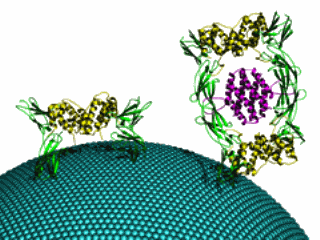New details about the infectious potency of poxviruses have been uncovered by researchers from the University of Alabama at Birmingham (UAB) and Saint Louis University using x-ray crystallography at the South East Regional Collaborative Access Team 22-ID beamline at the Advanced Photon Source, which is located at the U.S. Department of Energy’s Argonne National Laboratory. This work furthers our understanding of how one protein in viral infections can subvert the body’s immune system and could speed the discovery of new drugs to combat inflammation and immune diseases such as atherosclerosis and rheumatoid arthritis.
The findings are published in the February 12, 2008, issue of the Proceedings of the National Academy of Sciences.
“Now we have a visual blueprint to guide our future studies on interferon-gamma binding protein, which one day may be used to prevent inflammatory disease,” said Mark R. Walter, an associate professor in the UAB Department of Microbiology and senior author on the study.
Interferon-gamma binding protein (IFN-[gamma]) is notorious for the role it plays in helping poxviruses replicate. Normally, when a virus enters the bloodstream, the immune system fights back by producing IFN-[gamma], which tells surrounding cells to fight the infection. Remarkably, somewhere during the evolution of the poxvirus, it captures an IFN-[gamma] receptor gene from its host and incorporates the interferon binding fragment of this protein into its own viral genome. As a result, poxvirus has a very efficient “blocker” of the IFN-[gamma] antiviral response, Walter said. The new study details the blocking mechanism via crystallography, the science of mapping the atomic structure of molecules using an intense x-ray beam.
Poxviruses include many classes of the invasive organism such as smallpox, cowpox, and monkeypox. Smallpox in particular has played a tragic role in human history: it is estimated that it caused between 300 million and 500 million deaths in the 20th century. Smallpox was declared officially eradicated in 1979, but other poxviruses remain a health threat.
“The damage that the smallpox virus has done to mankind is horrific and enormous, which is why we think it’s so important to understand more about the poxviruses and how they operate,” said Mark Buller, professor of microbiology and immunology at the Saint Louis University School of Medicine and a study author. “The more knowledge we have, the better we should be able to cope with other major viruses and diseases in the future.”
Contact: Mark R. Walter ([email protected])
The original version of this news release can be found at: http://main.uab.edu/show.asp?durki=116327
See: Anthony A. Nuara, Leigh J. Walter, Naomi J. Logsdon, Sung Il Yoon, Brandi C. Jones, Jill M. Schriewer, R. Mark Buller, and Mark R. Walter: "Structure and mechanism of IFN-[gamma] antagonism by an orthopoxvirus IFN-[gamma]-binding protein," Proc. Natl. Acad. Sci. USA 105(6), 1861 (February 12, 2008). DOI: 10.1073/pnas.0705753105
This work was funded by National Institutes of Health grants AI47300 (to M.R.W.) and N01-AI-15436 (to R.M.B.) and a University of Alabama at Birmingham Center for Emerging Infections and Emergency Preparedness pilot grant (to M.R.W.). A.A.N. was supported, in part, by an American Heart Association predoctoral fellowship. Use of the Advanced Photon Source was supported by the U.S. Department of Energy, Office of Science, Office of Basic Energy Sciences, under contract no. DE-AC02-06CH11357.
Argonne National Laboratory brings the world's brightest scientists and engineers together to find exciting and creative new solutions to pressing national problems in science and technology. The nation's first national laboratory, Argonne conducts leading-edge basic and applied scientific research in virtually every scientific discipline. Argonne researchers work closely with researchers from hundreds of companies, universities, and federal, state and municipal agencies to help them solve their specific problems, advance America's scientific leadership and prepare the nation for a better future. With employees from more than 60 nations, Argonne is managed by UChicago Argonne, LLC for the U.S. Department of Energy's Office of Science.

